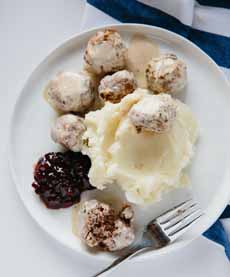
[1] Classic Swedish meatballs. Here’s the recipe (photo © The Kitchn).
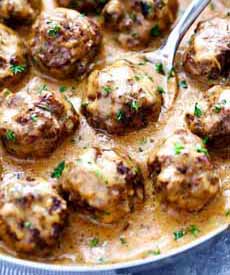
[2] Some people like lots of the sour cream gravy.Here’s the recipe (photo © The Recipe Critic).
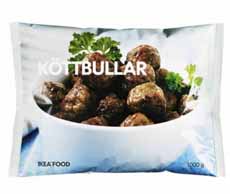
[3] Frozen meatballs from Ikea are available in beef/pork, chicken or vegan (photos #3, #4, and #7 © Ikea).

[4] Frozen mashed potatoes, also from Ikea.
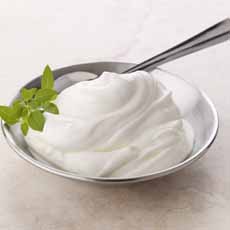
[5] The more sour cream, the merrier (photo © Wisconsin Dairy).

[6] Dill is the herb of choice with Swedish meatballs (photo © Good Eggs).
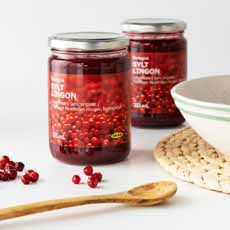
[7] Lingonberry preserves from Ikea are the perfect accent.
|
|
Cocktail parties in 1960s America had a set of de rigueur cocktail food that included cheese balls, deviled eggs, Lipton onion soup dip with potato chips, pigs in blankets, rumaki*, stuffed celery (often stuffed with olive cream cheese) and bite-size Swedish meatballs.
In Sweden, these small meatballs are made with a blend of pork and beef seasoned with allspice, ginger and nutmeg. They are served in a tangy sour cream sauce with a side of mashed potatoes and cream sauce.
In the U.S., many people serve Swedish meatballs over noodles. Well O.K., but that’s not authentic.
For the true Swedish meatball experience, a serving of lingonberry preserves is as essential as cranberry sauce is to turkey in the U.S.
What’s a lingonberry? It’s the Scandinavian version of America’s cranberry, also tart but half the size (see photo #7, below). They are different species of the same genus†.
Swedish meatballs are Sweden’s number-one dish, the unofficial national dish (although BBC Good Food gives that honor to kanelbulle, a cinnamon bun).
In the U.S. they have their own food holiday: March 9th.
FOR A QUICK DISH, HEAD TO IKEA
The Swedish-based retailer makes it easy, by selling the components for Swedish meatballs in their food markets. Ikea also sells a white gravy mix, but you can’t beat fresh sour cream—or homemade mashed potatoes, for that matter.
The gravy is easy to make, just sour cream, butter and flour. Here’s a classic from-scratch recipe from The Kitchn. For the potatoes, just boil and mash with butter and/or milk or cream, plus seasonings. Fresh dill is a nice touch.
At Ikea, you’ll find everything you need (except the fresh the sour cream sauce) to assemble the dish:
Meatballs, a.k.a. kottbüllar (frozen, in original, chicken and vegan, $8.99 per 2.2-pound package (photo #3 at left).
Mashed potatoes, a.k.a. allemansrätten (frozen), $2.49/package (photo #4 at left).
Cream sauce, a.k.a. gräddsås (a basic white sauce), $1.79/packet.
Lingonberry preserves, a.k.a. sylt lingon, $3.99/jar (photo #7).
SWEDISH MEATBALLS FROM SCRATCH
Make your own with one of these recipes:
Swedish meatballs recipe from The Kitchn (this has the best explanation and photos—photo #1 above).
Swedish meatballs from Alton Brown.
Swedish meatballs swimming in gravy from The Recipe Critic (photo #2).
MEATBALLS AROUND EUROPE
While we live in a city with a small chain of meatball shops (five types of meatballs, six sauces, a total of 30 combinations), our American experience has largely been the Italian-American meatball in tomato sauce.
So we took a look at the traditional meatballs of other European countries. For the world list, including meatballs from the Americas and Asia, head here.
Albania: Fried meatballs with feta cheese.
Alsace, France: A blend of beef and pork with onions, bacon, eggs and bread, served plain or with cream sauce.
Armenia: Stewed meatballs and vegetables, often over rice.
Austria: Fried meatballs.
Bosnia: Made from ground beef and served with mashed potatoes.
Belgium: A blend of beef and pork with bread crumbs and sliced onions. Variations use different types of meat and chopped vegetables.
Bulgaria: Made from ground beef, pork or a blend, often with diced onions and soaked bread, pan- fried or grilled.
Croatia: Typically made with beef, pork or a blend, and served with mashed potatoes or rice, often with a tomato-based sauce.
Denmark: Usually a blend of ground pork and veal with onions and eggs, flattened somewhat for pan frying.
Estonia: Similar to those of Finnish and Swedish cuisine.
Finland: Ground beef or a beef/pork blend or reindeer meat, mixed with breadcrumbs soaked in milk or beef stock and finely chopped onions or French onion soup mix. Traditionally served with gravy, boiled or mashed potatoes, lingonberry jam and sometimes, pickled cucumber.
Germany: Along with traditional meat blends, a very famous recipe is Königsberger Klopse, which contain anchovy or salted herring, and served with caper sauce.
Greece: Fried meatballs with bread, onions, parsley and mint; or stewed meatballs mixed with rice.
Hungary: Pork mixed with minced onions, garlic, paprika, salt and breadcrumbs, deep fried in oil or pork fat and eaten with potatoes or fozelék, a thick Hungarian vegetable stew. Liver dumplings are popular in soups.
Italy: Meatballs are generally eaten as a main course or in a soup. Made from beef and/or pork and sometimes poultry, salt, black pepper, chopped garlic, olive oil, Romano cheese, eggs, bread crumbs, and parsley, mixed and rolled by hand to a golf ball size.
The Netherlands: Usually made from minced beef and pork, eggs, onion and bread crumbs. They are associated with Wednesday, as evidenced by the saying woensdag, gehaktdag (Wednesday, meatball day). They are often served with boiled potatoes and vegetables.
Norway: Different types of meatballs, all typically small, with influences from Sweden and Spain, served with with potatoes, pasta or both.
Poland: Seasoned ground meat with onion, eggs and bread crumbs, typically fried and served with tomato sauce, mushroom sauce or brown gravy, along with potatoes or rice.
Portugal: Meatballs are usually served with tomato sauce and pasta.
Romania and Moldova: Meatballs are made with pork or poultry, moistened mashed potatoes and spices, usually deep fried.
|
|
Slovenia: Made with ground beef or a blend of pork and beef, served with mashed potatoes and a tomato-based sauce.
Spain (and Hispanic America): Originally a Berber or Arab dish, brought to Spain during the period of Muslim rule in the Middle Ages. Spanish albóndigas can be served as an appetizer or main course, often in a tomato sauce. Mexican albóndigas are commonly served in a soup with a light broth and vegetables.
Sweden: Ground beef or a blend of ground beef, pork and sometimes veal or elk, sometimes including breadcrumbs soaked in milk, finely chopped onions, broth and often, cream. They are seasoned with white pepper or allspice and salt. Traditionally served with sour cream gravy, mashed potatoes and lingonberry jam. Traditionally, they are small, around 2–3 centimeters (.79–1.18 inches) in diameter, although larger meatballs are often served at restaurants.
United Kingdom: Faggots are a type of spicy pork meatball. A faggot is traditionally made from pig’s heart, liver and fatty belly meat or bacon minced together, with herbs added for flavoring, and sometimes bread crumbs.
If you’re looking for ways to vary your meatballs, look no further!
________________
*Rumaki, created at Trader Vic’s, are skewers of broiled, bacon-wrapped chicken livers and water chestnuts.
†Here it is, food geeks: Lingonberry Order Ericales, Family Ericaceae, Genus Vaccinium, Subgenus Oxycoccus, Species Vitus-idaea. For the lingonberry, everything is the same except the species. The cranberry has four genuses (varieties): V. erythrocarpum, V. macrocarpum, V. microcarpum and V. oxycoccos.
Blueberry, bilberry/whortleberry and huckleberry are members of the same genus. Lingonberry is also known as cowberry.
CHECK OUT WHAT’S HAPPENING ON OUR HOME PAGE, THENIBBLE.COM.
|
























